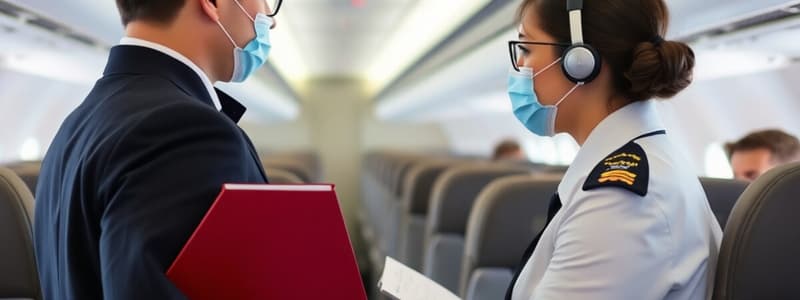Podcast
Questions and Answers
What is the maximum duration of a cabin crew briefing?
What is the maximum duration of a cabin crew briefing?
- 20 minutes
- 30 minutes
- 10 minutes
- 15 minutes (correct)
Which of the following is NOT a topic to be discussed during the cabin crew briefing?
Which of the following is NOT a topic to be discussed during the cabin crew briefing?
- Customer Service Techniques (correct)
- First Aid
- Emergency Procedures
- Safety and Security
What language shall the cabin crew briefing be conducted in?
What language shall the cabin crew briefing be conducted in?
- The crew members' common language
- The official language of the airline
- English only (correct)
- Multiple languages
What is the responsibility of the SCCM during the briefing?
What is the responsibility of the SCCM during the briefing?
What should the SCCM do if a crew member's knowledge is found to be inadequate?
What should the SCCM do if a crew member's knowledge is found to be inadequate?
What actions should crew members avoid during the briefing?
What actions should crew members avoid during the briefing?
What needs to be reported to the Cabin Crew Department after a flight?
What needs to be reported to the Cabin Crew Department after a flight?
What should the SCCM do if a crew member may have difficulties performing safety duties?
What should the SCCM do if a crew member may have difficulties performing safety duties?
Who is responsible for conducting the flight deck security search?
Who is responsible for conducting the flight deck security search?
What should crew members use when searching confined or dark areas?
What should crew members use when searching confined or dark areas?
What should be done immediately after searching compartments and confined areas?
What should be done immediately after searching compartments and confined areas?
What is the protocol if a foreign object is found during a security search?
What is the protocol if a foreign object is found during a security search?
When can the Aircraft Security Search Form be filled in?
When can the Aircraft Security Search Form be filled in?
Who checks that the amount of Security Search Forms is sufficient?
Who checks that the amount of Security Search Forms is sufficient?
Which area does not need to be included in post-flight security searches?
Which area does not need to be included in post-flight security searches?
What is a potential hazard when near an aircraft on the ground?
What is a potential hazard when near an aircraft on the ground?
Who is responsible for checking that passengers are properly seated in accordance with exit row regulations?
Who is responsible for checking that passengers are properly seated in accordance with exit row regulations?
What must passengers in exit row seats be able and willing to do?
What must passengers in exit row seats be able and willing to do?
Which of the following passengers is NOT permitted to occupy exit row seats?
Which of the following passengers is NOT permitted to occupy exit row seats?
What is a requirement for passengers occupying seats with direct access to emergency exits?
What is a requirement for passengers occupying seats with direct access to emergency exits?
What is the minimum age for a passenger to occupy an exit row seat?
What is the minimum age for a passenger to occupy an exit row seat?
What should the crew do if they suspect a passenger cannot open the exit for a safe evacuation?
What should the crew do if they suspect a passenger cannot open the exit for a safe evacuation?
Which group of passengers requires assistance and cannot occupy exit row seats?
Which group of passengers requires assistance and cannot occupy exit row seats?
Whose role includes briefing passengers with direct access to emergency exits?
Whose role includes briefing passengers with direct access to emergency exits?
What should be done if a blind passenger is unable to read Braille safety cards?
What should be done if a blind passenger is unable to read Braille safety cards?
What does the acronym MAAS stand for in the context of passenger assistance?
What does the acronym MAAS stand for in the context of passenger assistance?
In the case of passengers with intellectual or developmental disabilities, what should be done if they are on board without a companion?
In the case of passengers with intellectual or developmental disabilities, what should be done if they are on board without a companion?
How should restraint be used on a passenger with a mental or physical illness?
How should restraint be used on a passenger with a mental or physical illness?
What must be done if a passenger requires supplementary oxygen during the flight?
What must be done if a passenger requires supplementary oxygen during the flight?
When can cabin crew forego performing a one-to-one briefing for a blind passenger?
When can cabin crew forego performing a one-to-one briefing for a blind passenger?
What is the first step in assisting a passenger with potential mental disturbance?
What is the first step in assisting a passenger with potential mental disturbance?
How should supplementary oxygen be prepared for a passenger needing it?
How should supplementary oxygen be prepared for a passenger needing it?
What should be included in the normal procedures for cruise phase operation with fewer cabin crew members?
What should be included in the normal procedures for cruise phase operation with fewer cabin crew members?
Which emergency procedure must be considered in the event of an unruly behaviour incident?
Which emergency procedure must be considered in the event of an unruly behaviour incident?
If the SCCM becomes incapacitated, who should take over their duties?
If the SCCM becomes incapacitated, who should take over their duties?
What is the role of CCM1 when the SCCM is incapacitated?
What is the role of CCM1 when the SCCM is incapacitated?
What should the PIC do if there is no other SCCM available?
What should the PIC do if there is no other SCCM available?
In a situation with three cabin crew members, what is the protocol for seating positions if the SCCM is incapacitated?
In a situation with three cabin crew members, what is the protocol for seating positions if the SCCM is incapacitated?
What kind of briefing must the crew members operating as CCM1 receive?
What kind of briefing must the crew members operating as CCM1 receive?
What should the cabin crew ensure when a SCCM becomes incapacitated?
What should the cabin crew ensure when a SCCM becomes incapacitated?
What should the cabin crew member do if there isn't a full-size trolley to secure the galley entrance?
What should the cabin crew member do if there isn't a full-size trolley to secure the galley entrance?
Who is responsible for notifying the flight deck once the galley area is secured?
Who is responsible for notifying the flight deck once the galley area is secured?
What is the primary role of ABPs in an emergency situation?
What is the primary role of ABPs in an emergency situation?
During night flights, what must be done before opening the cockpit door?
During night flights, what must be done before opening the cockpit door?
What is the maximum duration a cabin crew member can visit the flight deck?
What is the maximum duration a cabin crew member can visit the flight deck?
What is required to secure the galley entrance during ground operations?
What is required to secure the galley entrance during ground operations?
What should the SCCM do if an abnormal situation occurs in the cabin?
What should the SCCM do if an abnormal situation occurs in the cabin?
During a short visit to the flight deck, where can a cabin crew member sit?
During a short visit to the flight deck, where can a cabin crew member sit?
Flashcards
BLND Passenger
BLND Passenger
A passenger with limited vision who uses Braille.
One-to-One Briefing for BLND Passenger
One-to-One Briefing for BLND Passenger
A one-on-one briefing for a blind passenger who cannot read Braille.
MEDA (Medical Passenger)
MEDA (Medical Passenger)
This group includes passengers with medical conditions, like mobility issues, requiring special assistance.
MAAS (Meet and Assist)
MAAS (Meet and Assist)
Signup and view all the flashcards
Passengers with Intellectual or Developmental Disability
Passengers with Intellectual or Developmental Disability
Signup and view all the flashcards
Cabin Crew Actions for Passengers with Intellectual or Developmental Disabilities
Cabin Crew Actions for Passengers with Intellectual or Developmental Disabilities
Signup and view all the flashcards
Passenger Requiring Supplementary Oxygen
Passenger Requiring Supplementary Oxygen
Signup and view all the flashcards
Informing Tour Operator or GOP about Oxygen Needs
Informing Tour Operator or GOP about Oxygen Needs
Signup and view all the flashcards
Exit Row Briefing
Exit Row Briefing
Signup and view all the flashcards
Vacant Exit Row
Vacant Exit Row
Signup and view all the flashcards
Exit Row Passenger Requirements
Exit Row Passenger Requirements
Signup and view all the flashcards
Prohibited Exit Row Passengers
Prohibited Exit Row Passengers
Signup and view all the flashcards
Prohibited Exit Row Passengers: Examples
Prohibited Exit Row Passengers: Examples
Signup and view all the flashcards
Exit Row Passenger Requirements (Unstaffed Exits)
Exit Row Passenger Requirements (Unstaffed Exits)
Signup and view all the flashcards
Unsuitable Exit Row Passengers
Unsuitable Exit Row Passengers
Signup and view all the flashcards
Exit Row Passenger Responsibility
Exit Row Passenger Responsibility
Signup and view all the flashcards
Cabin Crew Presence During Ground Operations
Cabin Crew Presence During Ground Operations
Signup and view all the flashcards
SCCM Role During Cabin Emergencies
SCCM Role During Cabin Emergencies
Signup and view all the flashcards
Securing the Galley During Evacuation
Securing the Galley During Evacuation
Signup and view all the flashcards
Galley Lights During Night Flights
Galley Lights During Night Flights
Signup and view all the flashcards
Cabin Crew Flight Deck Visits
Cabin Crew Flight Deck Visits
Signup and view all the flashcards
Cabin Crew Waiting in Flight Deck
Cabin Crew Waiting in Flight Deck
Signup and view all the flashcards
Flight Deck Door Closure
Flight Deck Door Closure
Signup and view all the flashcards
SCCM Notification of Forward Lavatory Crew Member
SCCM Notification of Forward Lavatory Crew Member
Signup and view all the flashcards
Who is the SCCM?
Who is the SCCM?
Signup and view all the flashcards
What is a crew briefing?
What is a crew briefing?
Signup and view all the flashcards
How does the SCCM evaluate the crew during the briefing?
How does the SCCM evaluate the crew during the briefing?
Signup and view all the flashcards
What should the SCCM report to the PIC?
What should the SCCM report to the PIC?
Signup and view all the flashcards
What does the SCCM check in flight bags?
What does the SCCM check in flight bags?
Signup and view all the flashcards
What topics are covered during the briefing?
What topics are covered during the briefing?
Signup and view all the flashcards
Is the briefing an exam?
Is the briefing an exam?
Signup and view all the flashcards
Which language is used during the briefing?
Which language is used during the briefing?
Signup and view all the flashcards
Incapacitated SCCM
Incapacitated SCCM
Signup and view all the flashcards
CCM1 briefing
CCM1 briefing
Signup and view all the flashcards
Seating Position change when SCCM is incapacitated
Seating Position change when SCCM is incapacitated
Signup and view all the flashcards
Emergency Seating Position changes
Emergency Seating Position changes
Signup and view all the flashcards
Normal Procedures with reduced cabin crew
Normal Procedures with reduced cabin crew
Signup and view all the flashcards
Emergency Procedures with reduced cabin crew
Emergency Procedures with reduced cabin crew
Signup and view all the flashcards
Emergency Descent Procedures
Emergency Descent Procedures
Signup and view all the flashcards
Prioritizing tasks with reduced cabin crew
Prioritizing tasks with reduced cabin crew
Signup and view all the flashcards
Flight Deck Security Search
Flight Deck Security Search
Signup and view all the flashcards
Using Flashlights
Using Flashlights
Signup and view all the flashcards
Closing Compartments
Closing Compartments
Signup and view all the flashcards
Handling Foreign Objects
Handling Foreign Objects
Signup and view all the flashcards
Security Search Form
Security Search Form
Signup and view all the flashcards
Security Search Form Availability
Security Search Form Availability
Signup and view all the flashcards
Completing the Security Search Form
Completing the Security Search Form
Signup and view all the flashcards
Post-Flight Search
Post-Flight Search
Signup and view all the flashcards
Study Notes
Table of Contents
- Corendon Airlines Standard Operating Procedures, Chapter 2
- Communication between Flight Deck and Cabin
- Critical Phases of Flight and Sterile Flight Deck
- Reporting Emergencies, Anormalities during Sterile Flight Deck
- Admission to Flight Deck
- Reduction of Cabin Crew during Ground Operations and In Unseen Circumstances
- Cabin Baggage
- Maximum Number of Passengers
- Carriage of Special Categories of Passengers (SCP)
- Passenger with Reduced Mobility (PRM)
- Passengers needing Supplementary Oxygen
- Unaccompanied Minors (UNMR)
- Pregnant Passengers
- Infants
- Children (Minor)
- Adults
- Potentially Threatening Passengers
- Live Animals
- Service / Guide Animals
- Passengers with Injuries or Illness
- Illness / Injury on Board
- Death on Board
- Exit Row Seating Regulations
- Pre-flight Procedures
- Preparing for Duty
- Pre-flight Briefing
- Security Procedures
- Cabin Emergency and Safety Equipment Check
- Cabin Log
- Cabin Emergency Exit Light Check
- Passenger Address System and Interphone System
- Catering
- Cabin Cleaning
- Lavatory Checks
- Dangerous Goods
- Inadvertent Carriage of Dangerous Goods
- Detection of Prohibited Goods
- Dangerous Goods Training
- ETOPS Operation Information
- Cabin Operations During and Post Pandemics
- Cabin Crew Stations
- Standard Door Operations
- Conditions for an Inoperative Door
- Passenger Safety Briefings
- Use of Portable Electronic Devices (PED)
- Smoking Restrictions
- Cabin Crew Seating Regulations
- Cabin Checks During Flight Phases
- Fire Prevention
- Lavatory checks
- Security Procedures
- Unruly Passengers
- Turbulence
- Re/Fuelling / Defueling
- Disembarkation of Passengers
- Debriefing
- Transit Procedure
- De-icing / Anti-icing
- Aircraft Critical Surfaces and Contamination
- Aircraft Weight and Balance
- Before Boarding
- Boarding Procedure
- Boarding Completed Procedure
- Passengers Who Decide not to Fly
- End of Boarding
- Emergency Equipment
- Passenger Announcements
- Inflight Service
Studying That Suits You
Use AI to generate personalized quizzes and flashcards to suit your learning preferences.




